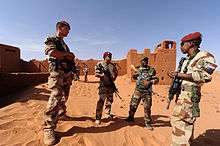Operation Barkhane
| Operation Barkhane | |||||
|---|---|---|---|---|---|
| Part of the 2012 Northern Mali conflict, Insurgency in the Maghreb and the War on Terror | |||||
 French soldiers (3rd RPIMa) and Nigerien. Fort Madama in Niger, 12 November 2014. | |||||
| |||||
| Belligerents | |||||
|
|
| ||||
| Commanders and leaders | |||||
|
|
| ||||
| Strength | |||||
| 3,000 French troops[1] | 3,000 fighters (all groups)[2] | ||||
| Casualties and losses | |||||
|
| 65 killed, 60 captured[3] | ||||

| ||||||
Operation Barkhane is an ongoing anti-insurgent operation in Africa's Sahel region, which commenced 1 August 2014.[4] It consists of a 3,000-strong French force, which will be permanent and headquartered in N’Djamena, the capital of Chad.[1] The operation has been designed with five countries, and former French colonies, that span the Sahel: Burkina Faso, Chad, Mali, Mauritania and Niger.[1] These countries are collectively referred to as the "G5 Sahel."[5]
The operation is named after a crescent-shaped dune in the Sahara desert.[6]
Background
The operation is the successor of Operation Serval, the French military mission in Mali,[6] and Operation Epervier, the mission in Chad.[7]
Aim
The operation is "to become the French pillar of counterterrorism in the Sahel region."[5] According to French Defence Minister, Jean-Yves Le Drian, the main objective of Operation Barkhane is counter-terrorism:[4] "The aim is to prevent what I call the highway of all forms of traffics to become a place of permanent passage, where jihadist groups between Libya and the Atlantic Ocean can rebuild themselves, which would lead to serious consequences for our security."[8] French President, François Hollande, has said the Barkhane force will allow for a "rapid and efficient intervention in the event of a crisis" in the region.[6]
The operation will target Islamist extremists in Mali, Chad and Niger,[4] and will have a mandate to operate across borders.[4]
Forces committed
French Forces
The French force is a 3,000-strong counter-terrorism force,[1] with 1,000 soldiers to be deployed indefinitely in Mali. These soldiers will be focused on counter-terrorism operations in northern Mali, with another 1,200 soldiers stationed in Chad, and the remaining soldiers split between a surveillance base in Niger, a bigger permanent base in Ivory Coast, and some special forces in Burkina Faso.[1]
According to original plans, the French forces will be supplied with 20 helicopters, 200 armored vehicles, 10 transport aircraft, 6 fighter planes, and 3 drones.[1] French Army Aviation currently have two Aérospatiale SA 330 Puma's in Chad.[9]
The division of labor between France and the G5 Sahel has been established by four permanent military bases:[5] (1) headquarters and an air force base in the Chadian capital of N'Djamena (under the leadership of French Général Palasset); (2) a regional base in Gao, north Mali, with at least 1,000 men; (3) a special-forces base in Burkina Faso's capital, Ouagadougou; (4) an intelligence base in Niger’s capital, Niamey, with over 300 men.
The Niamey air base is strategically important because it hosts drones in charge of gathering intelligence across the entire Sahel-Saharan region.[5]
Operations
Operations commenced 1 August 2014. French Forces sustained their first casualty during a battle in early November 2014, which also resulted in 24 jihadists dead.[3]
See also
References
- 1 2 3 4 5 6 "François Hollande’s African adventures: The French are reorganising security in an increasingly troubled region". Economist.
- ↑ "Jihadist threat not as big as you think". CNN. 29 September 2014. Retrieved 9 October 2014.
- 1 2 3 "French Military Says 24 Jihadists Killed in Mali". ABC News. Retrieved 9 November 2014.
- 1 2 3 4 France sets up anti-Islamist force in Africa's Sahel, bbc.co.uk.
- 1 2 3 4 http://nationalinterest.org/feature/welcome-frances-new-war-terror-africa-operation-barkhane-11029
- 1 2 3 Hollande announces new military operation in West Africa, france24.com.
- ↑ Opération Barkhane, French Ministry of Defense.
- ↑ France Launches New Sahel Counter-Terrorism Operation Barkhane, ibtimes.co.uk.
- ↑ AirForces Monthly. Stamford, Lincolnshire, England: Key Publishing Ltd. November 2015. p. 23.